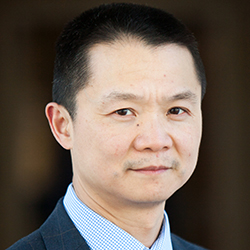What are the Equitable Guardrails of Fare-Free Transit?
As demand for cutting costs grows, could a free service actually cost Americans more? While fare-free transit (FTT) appears to be free, ultimately, someone must pay.
 Professor Marco Nie, with Ph.D. students Tianxing Dai and Hongyu Zheng, examined fare-free transit through the lens of distributive justice in their paper, “Is Fare-Free Transit Just? Quantifying the Impact of Moral Principles on Transit Design & Finance.”
Professor Marco Nie, with Ph.D. students Tianxing Dai and Hongyu Zheng, examined fare-free transit through the lens of distributive justice in their paper, “Is Fare-Free Transit Just? Quantifying the Impact of Moral Principles on Transit Design & Finance.”
Proponents argue that FFT can help reduce operating costs, attract choice riders, and bring about transformative changes in social justice. In 2021, President Joe Biden issued an executive order that called for a comprehensive approach to “advancing equity for all” and to “the improvement of communities that have been historically underserved.”
However, as this paper dissects, “[i]n the absence of farebox revenue, a transit system must either cut services or turn to alternative sources, such as local dedicated taxes and fees levied on drivers.”
For decades, Marco Nie has been working to better understand and predict the behavior of transportation systems and their users, and formulate policy and strategies that promise to make these systems efficient, sustainable, and equitable.
Social justice is inherently tied to the issue of FFT: After researching the issue through an egalitarian and utilitarian lens, the team found that “FFT can be both just and utility-maximizing if one can raise taxes and charge drivers with impunity. However, as the flexibility in finance diminishes, so does the appeal of FFT.”
“While many believe it is fair for the users to pay for the service, our result suggests that if we follow an egalitarian approach (emphasize the need to help disadvantaged travelers), we should charge driver fees and use the driver fee revenue to fund public transit; if we follow a utilitarian approach (emphasize the need to maximize the total utility of all travelers), we should impose a high local option tax to fund public transit,” said Tianxing Dai.
“While this implies that FFT is desirable,” Dai continued, “we are often limited in how much driver fee and local option tax we can charge. When we set a reasonable cap on the driver fee and tax, we find that a non-zero fare is necessary to support a sustainable and high-quality transit service.”
For Chicagoans, “the Rawlsian egalitarian can justify FFT—at the current tax rate of about 1%—only if drivers pay about $1,800/year to fund transit, which amounts to about 18% of an average U.S. household's driving cost.”
As the first author of the paper, Dai was in charge of framing the research question, building the model, conducting analysis, running numerical experiments, and drafting the paper. He said the most challenging part of conducting this research was building and calibrating a model that represents reality.
“We sometimes need to make necessary assumptions that simplify the analysis and calculation, without losing the capability to represent key features and quantify the tradeoffs in the problem,” he said. “Moving forward, we need to consider how our research could inform and influence decision-making. I hope practitioners find our model useful, and use it as a light-duty tool that evaluates and guides policies.”
While the price of transit has always garnered attention, this issue has recently become very topical. This year, New York City tried to offset the cost of its mass transportation with congestion pricing—increased tolls levied on drivers entering Manhattan. Money earned from the tolls was proposed to help modernize NYC subways and buses, although the toll program was paused indefinitely earlier this month.
“From a transportation perspective, congestion pricing makes perfect sense,” Nie said. “Our results show that without congestion pricing, transit users are subsidizing the drivers by paying a higher fare—this is not an equitable outcome.”

